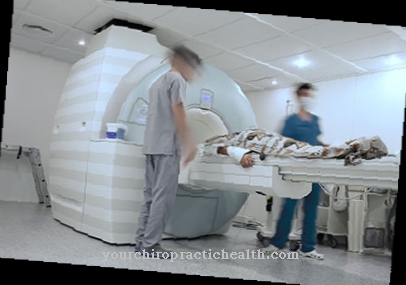The Myotonia congenita Becker belongs to the general group of so-called myopathies (muscle diseases). It is characterized by the delayed production of the resting membrane potential after a muscle contraction. This means that the muscle tone only slowly decreases.
What is Myotonia congenita Becker?

© blueringmedia - stock.adobe.com
The Myotonia congenita Becker is a muscle disease (myopathy), which belongs to the special group of myotonia. Myotonia is characterized by a long-lasting increased muscle tone. The muscle relaxes slowly after a muscle contraction. Myotonia is a disorder of the sodium ion channel.
The resting potential between potassium ions inside the cell and the sodium ions outside the cell is only slowly restored when excited. In relation to muscle tension (muscle tone), this means that a certain change caused by muscle strength is maintained for longer. For example, if the patient clenches his fist, it will take a while before he can open the fist again. The myotonia are usually genetic.
This leads to defects in enzymes which are responsible for the transport of chloride ions in the sodium channel. The Myotonia congenita Becker is also characterized by identical symptoms as the Myotonia congenita Thomsen, since both diseases affect the transport of chloride ions. With a prevalence of 1 in 25,000, Myotonia congenita Becker is a very rare muscle disease. The prognosis is very good, however. A reduction in life expectancy is not observed.
causes
A genetic defect in the CLCN1 gene on chromosome 7 is described as the cause of Myotonia congenita Becker. This gene is responsible for the formation of an enzyme that regulates the transport of chloride ions through the sodium channel. As a result of this enzyme defect, the chloride ions can no longer be transported so well, and the resting potential of the cell membrane is only slowly established.
The resting membrane potential is an actively generated cell potential that develops between the interior of the cell and the intercellular space. The so-called sodium-potassium ion pump constantly pumps potassium ions into the cell and sodium ions out of the cell. The potassium ion concentration is increased inside the cell and decreased outside. The reverse is of course also true for the sodium ions.
The resulting potential is actively maintained so that electrical impulses can be passed on via changes in potential. If the potential is reversed as a result of this pulse, the initial state is usually quickly restored. However, this process is delayed in Myotonia congenita Becker due to the disturbed transport of chloride ions.
The same applies to the Myotonia congenita Thomsen. Both diseases are caused by defects in the same gene. However, there are different mutations here. While Myotonia congenita Thomsen is inherited as an autosomal dominant trait, Myotonia congenita Becker follows an autosomal recessive inheritance.
Symptoms, ailments & signs
The main symptom of Myotonia congenita Becker is long-lasting muscle tension (muscle tone). The muscle does not relax immediately, as is usual for a normal muscle reaction, but rather with a delay. Posture triggered by voluntary muscle contraction is maintained longer. The delayed opening of the fist when the patient is clenched has already been mentioned.
Furthermore, after a long period of physical rest, getting up and walking is initially only possible with difficulty. After a so-called warm-up phase, the movements normalize again. The muscle stiffness is particularly pronounced in cold outside temperatures or when staying in cold water. When the skeletal muscles are tapped, a tonic contraction occurs, which is also known as percussion myotonia.
Patients fall more often and appear clumsy when grasping objects. However, muscle development is normal. It is even possible to have an athletic build because myotonia is not associated with muscle weakness. However, prolonged physical rest can lead to muscle weakness.
Diagnosis & course of disease
When diagnosing Myotonia congenita Becker, an anamnesis of the medical history is first carried out. Physical examinations such as tapping the skeletal muscles to produce percussion myotonia and electromyography follow. In electromyography, series of discharges occur which suggest myotonia. The differential diagnosis for Myotonia congenita Thomsen now takes place.
It is very difficult to tell the difference between the two diseases. In the anamnesis, the inheritance of the myotonia can be explored. If an autosomal recessive inheritance is indicated, it can be concluded that Myotonia congenita Becker is. However, only a genetic test can provide precise information.
Complications
The Myotonia congenita Becker results in considerable limitations and complications in the patient, which occur mainly in everyday life. In most cases, the muscles cannot relax immediately, so that certain activities cannot be performed by the patient. Standing up can also be a problem if the person concerned has rested beforehand and the muscles were not active.
The quality of life is significantly reduced by the Myotonia congenita Becker. Those affected also suffer from severe muscle stiffness, which also has a negative effect on the patient's posture. It is not uncommon for those affected to appear clumsy and, for example, cannot properly grip or lift objects.
This leads to severe restrictions in everyday life and extremely delays in development in children. Muscle weakness can also occur, so that the resilience of the person concerned is significantly reduced. A direct treatment of the Myotonia congenita Becker is not possible.
However, those affected are dependent on various therapies that can significantly alleviate the symptoms. There are usually no complications. In some cases, however, the heart muscle is also affected, so patients may need medication to prevent heart problems.
When should you go to the doctor?
If the muscle tension cannot be released despite a consciously initiated relaxation, a doctor is required. Delayed muscle response is unusual and should be presented to a doctor. A stiff posture, problems with the gripping function and disturbances in general movement sequences should be discussed with a doctor. If falls or accidents occur more frequently as a result of the symptoms, a medical clarification of the cause is necessary. A treatment plan must be drawn up so that relief from the symptoms can be initiated.
In the case of general severity after a period of rest, restrictions in locomotion after a break or unsteady walking, the person concerned needs help and support. A doctor is required to determine the existing disorders. A decrease in physical fitness, difficulties in fulfilling everyday obligations and an inability to carry out normal sporting activities must be discussed with a doctor. There is a condition that needs treatment.
If the symptoms persist for several days or if the disturbances increase, a doctor should be consulted. If the person concerned appears clumsy in everyday life, if he shows behavioral problems or if there are emotional problems, a doctor should be consulted. The physical impairment increases the risk of psychological complications.
Therapy & Treatment
Most patients with Myotonia congenita Becker do not require treatment. With a certain amount of training, they can learn to perfect their movements to compensate for symptoms. In severe cases, however, drug treatment is sometimes necessary. Mexiletine is given, which is known as an antiarrhythmic for cardiac arrhythmias.
This drug blocks the sodium channel. Acetazolamide, carbamazepine or diazepam can also be used. However, drug treatment should only be used for a short time, as it can have various side effects. However, drug treatment can be useful, especially if muscle stiffening has occurred as a result of exposure to cold.
You can find your medication here
➔ Medicines for muscle painOutlook & forecast
Myotonia congenita Becker has a differentiated prognosis. A cure is impossible because it is a hereditary disease. Doctors can only relieve symptoms. Often no lengthy treatment is necessary because the symptoms are minimal. With such a course, the patients receive information on how to compensate for the signs in everyday life.
Training units are mostly instructed by physiotherapists. These measures are sufficient to prevent impairments in the quality of life. If the course is severe, medication is indicated. The active ingredients available temporarily relieve the suffering. However, side effects sometimes occur during use. Stiff muscles are very common in everyday life. Clumsiness and poor posture are also characteristic. Resilience in professional and private life is significantly reduced. The Myotonia congenita Becker does not lead to a shortening of the lifespan.
According to statistical surveys, the disease occurs in one patient out of 25,000 people. Many affected people inherit Myotonia congenita Becker through their parents. The state of complaint usually remains at a similar level. Changes are very rare and occur gradually.
prevention
Myotonia congenita Becker is a genetic disease, so there is no possibility of prophylaxis. However, the onset of symptoms can be prevented. It is important to avoid the cold in particular. This also applies to bathing in cold water. Because the muscles stiffen very quickly.
Furthermore, continuous movement is necessary to counteract muscle stiffening. Exercise training also makes it possible to compensate for the symptoms of Myotonia congenita Becker.
Aftercare
With Myotonia congenita Becker, those affected have only a few and only limited follow-up measures available in most cases. For this reason, those affected should consult a doctor at an early stage to prevent other complications or complaints from occurring. It cannot heal on its own, so that the patients are dependent on the help of a doctor.
Follow-up care often also includes physical therapy or physiotherapy in order to relieve the symptoms permanently and correctly. Many of the exercises from such therapies can be repeated in your own home in order to accelerate healing. With Myotonia congenita Becker, the help and care of one's own family is often very important.
When taking medication, ensure that the dosage is correct and that it is taken regularly in order to counteract the symptoms. Those affected should always consult a doctor first if anything is unclear or if they have any questions. Myotonia congenita Becker does not usually reduce the life expectancy of the patient. Often, contact with other affected persons is also very useful, as this can lead to an exchange of information.
You can do that yourself
Myotonia congenita Becker can be treated by the patients themselves through some self-help measures and various means from the household and nature.
Various physiotherapy exercises make it easier to get up and walk in the morning. By repeating the movement, the so-called "warm-up phenomenon" can be achieved, in which the movements can be carried out increasingly easier and with less pain. In cold outside temperatures, the patient should wear warm clothing, as the muscle stiffness is particularly pronounced under these conditions. If medication has been prescribed for the disease, the use of alternative remedies should be discussed with the doctor beforehand. The doctor can give tips for an adapted diet, through which the typical muscle complaints can often be reduced.
Since there is an increased risk of accidents with Myotonia congenita Becker, the patient should not be left alone. In the event of a fall, it is important to call the emergency doctor and give the person concerned first aid. If there are repeated accidents, adjustments must be made to the household, such as support handles or handrails. In the advanced stage, the patient is dependent on a wheelchair.
























.jpg)



